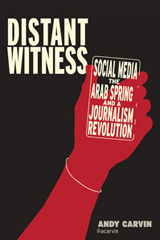

By R. Alan Clanton
Thursday Review Editor
In December 2010 a young food vendor named Mohamed Bouazizi, working the streets of Sidi Bou Zid in Tunisia, got into a heated argument with local police when he refused to pay the “inspectors” a small fine (read: bribe) for what amounted to—according to witnesses—a trivial violation of his license to sell a small selection of fruits and vegetables from his push cart. The argument turned nasty, and after a scuffle, the cops impounded his cart along with its contents. A few hours later, after a failed attempt to reclaim his cart, he set himself on fire in front of a municipal building while hundreds watched, including bystanders with video cameras and smart phones. The young man was rushed away with burns across most of his body. Later in the day, crowds gathered in protest, but not much happened until the next afternoon when that video hit the internet. Within 48 hours, as outrage spread rapidly across Tunisia, the Arab Spring erupted—soon spilling over into a dozen other Arab nations, inciting chaos and insurrection, leading eventually to the collapse of regimes in Tunisia, Libya and Egypt.
A new book by NPR’s Andy Carvin, Distant Witness: Social Media, the Arab Spring and a Journalism Revolution, (City University of New York CUNY Journalism Press, 2013) retells this striking and remarkable series of events—a chain reaction which swept across the Arabic-speaking world with game-changing (and some would say still unknown) consequences. As opposed to the daily doctrine of officialdom or the often incestuous process of the 24-hours cable news cycle, Carvin’s retelling of these dramatic months is street-level. Though he makes clear that he does not suggest that social media—Twitter, Facebook, so forth—were responsible for the revolutions, he shows us how the energies of crowd outrage and the courage of some individuals, with specific personal technologies in hand, can transform the craft of journalism into a tool of immediacy and power.
Carvin’s book, which begins with those events in Tunisia, tracks the way that the news of these revolutions entered into the world’s consciousness and how, in the following weeks and months, it spread into nearby nations as streets and town squares became flashpoints of confrontation between average Arabs and their despotic, corrupt leaders—a challenge to authority that is still unresolved in Egypt and still playing itself out violently in Syria.
Though Carvin places great value on social media and its ability to turn individuals into reporters—smart phones with cameras, tweets from the midst of street violence, makeshift newsrooms consisting of only a small laptop and using Skype as its uplink to the outside world—Carvin also seems to understand the inherent danger of a world without editors or fact-checkers. While much of the mainstream press watched events unfold from a comfortable distance—measuring their reports against official statements by the Obama administration or by comparable reports from other news sources—amateur newshounds with the closest access to streets and sidewalks issued minute-by-minute, albeit sometimes flawed and unsubstantiated, reports from the true front lines of the revolutions.
Though they were clearly not the cause of the rebellions, the ubiquitous tools of social media may have been decisive in the outcome of the Arab insurrections. But Libya and Egypt stand as examples of revolutions unlikely to succeed had it not been for the thousands of citizens communicating en masse, not only with the outside world, but more importantly with each other.
A few days after I began reading this book, a friend sent me an email in which he asked a rhetorical question: what if these tools had been available in other times? Would such power have affected the outcome of the Hungarian Uprising of 1956? What about Tiananmen Square?
Technology in the hands of the street has worked before to mitigate despotism. Recall for a moment the power exerted by the fax machine during the failed coup attempt in the Gorbachev era, as dozen and eventually hundreds of average Russians transmitted desperate reports to the outside world as the dramatic confrontation played itself out. The grim-faced members of the hardline putsch had mobilized troops and rolled in columns of tanks, but they had not thought to shut down the telephone systems in Moscow, Leningrad and other cities. Citizen innovation and adaptability prevailed, and news of what was really happening in Russia swept through the world’s daily media. Soon afterwards, the Soviet Union would begin to dissolve. It was the beginning of the end for Marxist-Leninism, and no shots had been fired.
The revolutions in the Arab world proved all-too-frequently violent. Carvin tracks the daily flood of information which streamed through his—and others’—smart phones, the flow of messaging measured in minutes and sometimes seconds. Coupled with the often shaky but riveting video streams, the tweets and images of daily mayhem and street struggles made for captivating—if sometimes incomplete—journalism. Still, the major news organizations often had little else to turn to, and the visceral real-time accounts of the Twitterers fed into mainstream news reports for audiences around the world.
Underpinning Carvin’s book is the global theme of journalism challenged—not just the oft-repeated, existential threat to the traditional business model of news, but also to the very essence of how we gather information, synthesize it, and send that information back out to our friends, family and networks as digitized “news,” or what we seem daily to be redefining as news in a technological arena changing faster than most of its members can track. The French News Agency calls Carvin’s Distant Witness “a glimpse into journalism’s future.”
Distant Witness is a fast-paced read which you will find hard to put down.